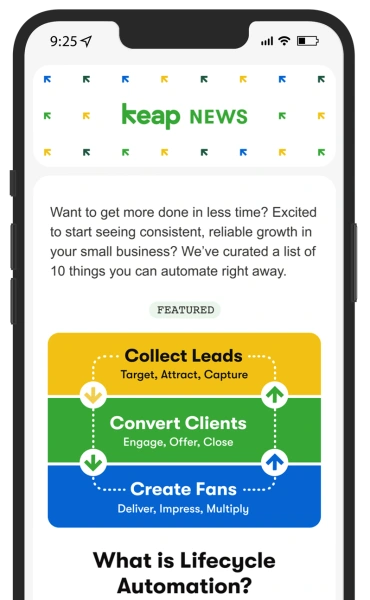by Paul Sokol
Do you remember digital alarm clocks? They were pretty simple: you set a time to wake up and when the alarm rang, if you hit snooze, a fixed period of time passed before the alarm unleashed another obnoxious slumber disruption. These days, most smart devices still retain basic alarm functionality, but there are also other bells and whistles that their relatives could have only dreamed of.
I use my iPhone set to wake me with a specific song each work week morning. This way, I don't have to remember to turn off my alarm on Friday night if I want to sleep in on Saturday morning. On the surface of your alarm, there is the basic functionality, but when you dig in a bit deeper, you discover tricks and features, like using a song for an alarm or adjusting the message it displays when it goes off.
When you need to glean information from the Infusionsoft Campaign Builder, the process is pretty similar to your alarm: You have the basic face-value Reporting mode, but if you explore a bit deeper you can get extremely targeted and meaningful reporting. This post is going to empower you to pull the most useful campaign data within your Infusionsoft application.
Reporting Mode for quick reporting
Reporting Mode by itself is a great way to get a quick view of how things are performing. You can either see the current state of where people are in your campaigns or you can look at historical data at any moment in time. Again, this is just what you see on the surface and at the end of this post, I will show you how to pull your reports directly from Reporting mode.
First, it is critical to understand that under the hood Campaign Reporting uses the same framework as any other Infusionsoft report. Hence, I'd like to explain the different types of reporting available in the Marketing reports. By understanding better these five angles to look at a campaign, you’ll be able to effectively use the Reporting mode.
If you hover onto the navigation and tap on the Reports link…

...you’ll get a list of all the available ways to slice and dice the marketing data provided by Infusionsoft. Casually hiding out, innocuously in the middle the list of reports, are these five workhorses:

When you look at the speedometer of your car, it tells you how fast you are going at that very moment. Campaigns are similar. At any given time you can see how your campaigns are performing.
However, in a car, there is more to pay attention to than speed. You have a gas gauge, temperature gauge, and so on.
How much gas is left? There’s a gauge for that. How far have we driven? We have a running total.
We may not need those bits of information all the time but each one is important to at least be aware of.
Campaigns are similar because you need different views into the data to answer different questions. Each of these five campaign reports answers a specific question regarding a campaign.
One pro tip to remember before we get going: with any of these five reports you can also filter down the results based on tags and other information in the contact record. They basically have all the available search filters you’d find with a regular Contact search. This means you can get supremely granular with your reporting if needed.
Campaign question No. 1: “Who is in a campaign?"—The Unique Campaign Contacts Report
When you simply want to see how many people are in the campaign, this is the report for that. The "Unique Campaign Contacts" report will show you everybody that is in a particular campaign along with how many different sequences they are in.

Having a high level general campaign report like this is helpful, but sometimes you need to get specific into the campaign and answer the question...
Campaign question No. 2: “Who is in (or WAS in) a specific campaign sequence?"—The Campaign Contacts Report
When you want to see how many people are in a specific sequence within a campaign, this is the report to use. Select the campaign sequence(s) on which you want to report on and go. This report can also be used for historical information too, not just current sequence status, so you're able to answer two questions with one report.

To master this report’s power, there are three states to be aware of. For each sequence within a campaign someone can be:
- Active: "Who is in the sequence right now?" This means the contact is in the sequence and they are waiting to receive more things (emails, tasks, etc.). As far as the current status of a campaign, this is what you want to search for to find people actively receiving things from a campaign.
- Queued: "Who was in this sequence but didn't move ahead in the campaign?" This means the contact has received all sequence steps and they did not achieve a goal further in the campaign and they did not automatically flow into another sequence. Think of it like a holding bucket for everyone that went through a sequence and that is where the campaign stopped for them. Since these contacts are no longer "active" in the sequence, this is a historical sequence data point. They are “queued” up for something else in the future.
- Done: "Who was in this sequence and DID move ahead in the campaign?" This means the contact was in a sequence and they did achieve a goal further into the campaign or flowed into another sequence; the sequence has "done" its job of pushing someone along within the campaign. Similar to Queued, this is another historical data point for sequences. You can filter by the Stop Date, which is when the sequence became Done, on this report as well.
Reporting question No. 3: “Who is waiting to receive a specific sequence step in a campaign?"—The Campaign Contacts Waiting Report
Have you ever wondered how many people will get a specific email, task, or tag next? This is the report you need to use. You can search for a specific step within a sequence and see not only how many people are waiting to get it, but when it is scheduled.

Let’s take a moment to summarize before we move on:
- You can find who is in a campaign
- You can find who is active in a specific sequence of a campaign
- You can find who is scheduled to receive a specific step within a particular sequence
That gives you insight at the highest level campaign view, giving you a high-level view into how your campaign is faring right now—similar to how your speedometer tells you your speed in real time.
What's next? The historical stuff—what has happened in a campaign so far.
The odometer of your car shows you how many miles you've driven. Inside Infusionsoft, you can also look at historical data to see what has occurred over the course of your campaigns.
Reporting question No. 4: “Who has received a specific sequence step within a campaign?"—The Sequence Step Recipients Report
When you want to see how many people have received a specific step from a campaign's sequence, you will want to use sequence step recipients. You'll not only be able to see who has received a particular step, but when the step was processed for that individual.
The report functions very similar to the previous report that shows who is waiting for a step.

Reporting question No. 5: “Who has achieved a particular campaign goal?"—The Campaign Goal Completion Report
When you want to see how many people have achieved a certain goal within a campaign, this is the report you need to use. This is one of the reports I rely on heavily when determining campaign results because it truly is the meat and potatoes of campaign reporting.
By comparing how many people hit one goal to how many of those hit another goal, you can start seeing and measuring campaign effectiveness. For example, if 100 people opt-in to a free report (a webform goal) and 50 people actually download it (a link click goal), you have a 50 percent redemption rate.
This report allows you to establish baseline performance results that you can work to improve. You can also use those for predicting results. Given the previous example, if I can drive a thousand people to opt-in, I should expect about 500 downloads.
To summarize, historically:
- You can see who has received a specific step within a particular sequence
- You can see who has finished a sequence and stopped (queued) or who was in a sequence and moved on. Remember, these are from the "Campaign Contacts" report No. 2 we covered above
- You can see who has achieved a specific goal within a campaign
Thanks for explaining those reports Paul, but do I have to configure them manually each time?
Before we started peeling off the reporting layers in the beginning, I briefly mentioned Reporting Mode. While you can manually set the campaign reporting filters, Reporting Mode can be used to do most of the heavy lifting when you want to build campaign reporting.
Here is how: inside a published campaign, enter Reporting Mode in the upper right and view either "Current" or "Last x hours/days."

Hover over any object and you’ll see a blue person icon appear in the upper right. If you double-click into sequences, you can hover over the individual steps and get this same icon, as well.

If you click on that icon, it will take you into the pre-configured report for that object and mode. In the image above, I show a sequence in current Reporting Mode. When I click on that blue icon it will take me into the Campaign Contacts report and show me everyone in that sequence who is active. When you are in Performance Mode looking at active view, it actually shows you who is active and who is queued. The top number in blue is active and the bottom orange number is queued. Clicking into the report will just show active people, but you can click edit criteria/columns and adjust the sequence status filter to show queued or done contacts, as well.
From here you can save those reports and put them on your dashboard for easy, at-a-glance reporting.
What about email performance reporting?
There is a bonus reporting view you can only access when looking inside a sequence. If you are looking at any historical view, the system will show global open, click, and opt-out rates for the email within that time period.

That is a lot to remember! Can you make it easier for me?
You got it! When you need reporting, this should be your thought process when looking at Reporting Mode:
- Do I need historical or right-now data?
- Historical = “Last x hours/days” view
- Right now = “Current” view
- Find the object you want to report on. Remember, you can double-click into sequences to access the individual steps.
- Hover over that object and click on the blue person icon to go into the report.
- Click on edit criteria/columns and adjust as needed, particularly for historical reports so you can change the date ranges.

